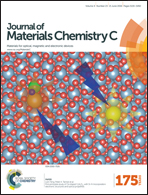An efficient energy transfer process in Nd3+:Yb3+ co-doped SrF2 powders containing Al3+ and prepared by the combustion synthesis technique
Abstract
Strontium fluoride (SrF2) powders containing aluminum (Al3+) and doped with rare-earth neodymium (Nd3+) and ytterbium (Yb3+) were synthesized using the combustion synthesis technique. Heat-treated (700 °C for 3 h) powder samples presented the SrF2 network arranged in a face-centered cubic phase. Under pulsed laser excitation at λ = 750 nm, at room temperature, near-infrared luminescence attributed to 4f–4f electronic relaxation 4F3/2 → 4I9/2 from Nd3+ was observed in the spectral range λ ∼ 850–930 nm for both Nd3+ doped and Nd3+:Yb3+ co-doped SrF2 powder samples. Nd3+:Yb3+ co-doped SrF2 powder samples presented an additional luminescence band peak at λ ∼ 980 nm assigned to the 2F5/2 → 2F7/2 transition of Yb3+. Quenching of the luminescence originating from the 4F3/2 state of Nd3+ was observed in co-doped samples and the phenomenon was assigned to energy transfer (ET). ET was investigated by analysing the near-infrared luminescence dynamics of Nd3+ using the Inokuti–Hirayama model. The energy transfer mechanism was found to be of a quadrupole–quadrupole type with efficiency as high as 62%. Our results show that this system is a potential phosphor for photonics applications involving near-infrared light sources.


 Please wait while we load your content...
Please wait while we load your content...